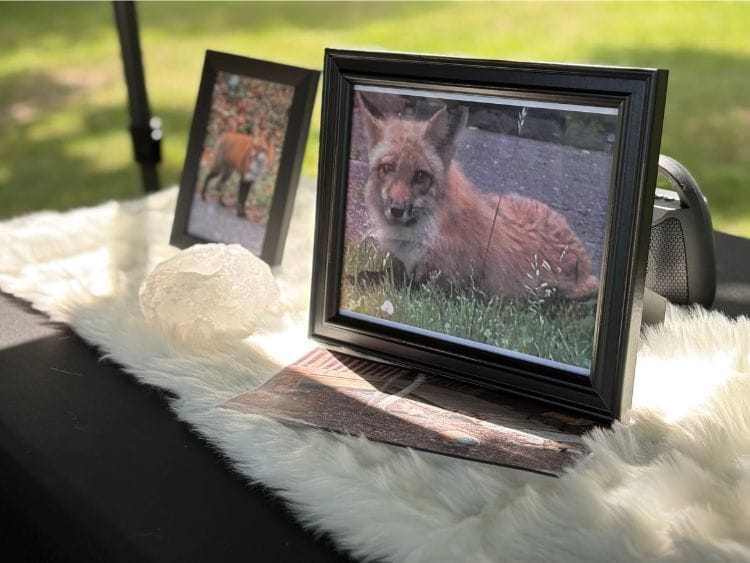For years, Bella the fox crept through the suburban streets and green spaces of Bells Corners, with no fear of the modernizing landscape in what was, decades ago, farmers' fields.
The fox with no tail was a regular sight in backyards, schoolyards, and even the local cemetery. It’s not exactly sure when Bella first started making her rounds, but some of the first sightings came during the COVID-19 pandemic — a time when neighbours found joy in her presence amidst stay-at-home orders and lockdowns.
In early July, Bella’s body was found on Robertson Road after being hit by a vehicle. It left the community shattered.
Trudy Ferguson, a master naturalist and wildlife photographer, is starting a petition to have the city install signs which remind drivers and pedestrians to watch for wildlife. It’s not a new concept with similar signage in the Central Park and Hunt Club neighbourhoods notifying of coyotes.
“I would like to see some awareness for people to respect urban wildlife,” Ferguson told the Lookout. “We all need to do our role and respect and embrace wild animals from a distance.”
Sightings of wild animals are not uncommon in Ottawa. In at least two incidents, black bears were spotted roaming through Barrhaven. Kanata and Hunt Club have had moose sightings, with one of the 1,000-pound creatures dipping in a Uplands Drive pool in 2020.
In 2023, a bear was shot and killed in Kanata. At the time, authorities tried to remove the animal safely, but said it had to be put down “to ensure the safety of residents in the surrounding area.”
The same bear was previously seen in Bell’s Corners near Bell High School.
Wildlife advocate Lisa Marie Darragh, who is also a Bell’s Corners resident, was outraged when she heard the bear had been killed. To raise awareness, she launched an online group to educate people about how to coexist safely with wildlife.
“If you choose to live in an urban forest community, it should be a rule that you choose to embrace wildlife,” she told the Lookout. ”I honestly think there should be pamphlets in people's houses when they buy the home, saying you will be visited by wildlife, and that you need to accept that. With the proposed densification coming from the city, that's going to change a lot of things, and it's going to make it harder for wildlife to have safe spaces.”

Fr. Daryold Corbiere Winkler of St. Basil’s Church smudges the crowd at Williams Park on July 19. Photo by Charlie.
A fond farewell and the need to coexist
On July 19, about 35 people attended a vigil at William's Park in Bells Corners to say goodbye to their furry fox friend and renew calls for enhanced safety measures to protect wildlife in urban settings.
The roughly hour-long service was led by Fr. Daryold Corbiere Winkler of St. Basil’s Church, an Ojibway Catholic priest from M'Chigeeng First Nation, who performed a smudging ceremony.
The Indigenous ceremony is practiced for cleansing and purification. It involves burning sacred medicines like sage, cedar, sweet grass, and tobacco, and using the smoke to cleanse a space, object, or person. This practice promotes spiritual well-being and connection to the natural world.
During remarks, Fr. Daryold mentioned how all major religions have scripture that references the respect animals deserve. Community members shared their stories of Bella and said they were never afraid.
A Bell High student said the fox made a cameo in her yearbook. One man said the furry friend once walked beside him during a morning walk, which he mistakenly thought was his dog. Another woman said she’d throw chicken legs in her backyard, which Bella would take to her young kits. One Mexican national who immigrated to Canada from the United States a year ago said they encountered Bella during their first day in Bell’s Corners and saw the sly fox as a community mascot.
Despite Bella’s tragic end, naturalist Ferguson said Bella’s Corners showed a successful example of how a fox and a community could live together in urbanization for five years.
She said the first step in creating co-habitats is dispelling misconceptions that if an animal is wild, it must be dangerous.
“The fear of getting attacked is mostly a fairy tale. It’s based on fear, misconceptions and misinformation we had for years growing up,” said Ferguson. “Foxes manage the tick and rodent populations. They provide benefits as pest control. It heals and keeps the ecosystem in balance.”

A Bells Corners resident made Fox cupcakes for the ceremony. Photo by Charlie Senack.
What are some of those misconceptions?
With bears, Ferguson said, if you hear one huff, it isn’t an automatic sign they plan to attack you. Instead, she said they will give several warnings before making contact.
And if you see a raccoon outside during the day, it doesn’t mean the creature has rabies.
“Raccoons actually do come out during the day, especially when they have babies and are hungry,” said Ferguson. “If there are too many opportunistic feeders at night, they will also come out during the day. Foxes are the same way. They play a valuable role in maintaining a healthier environment.”




